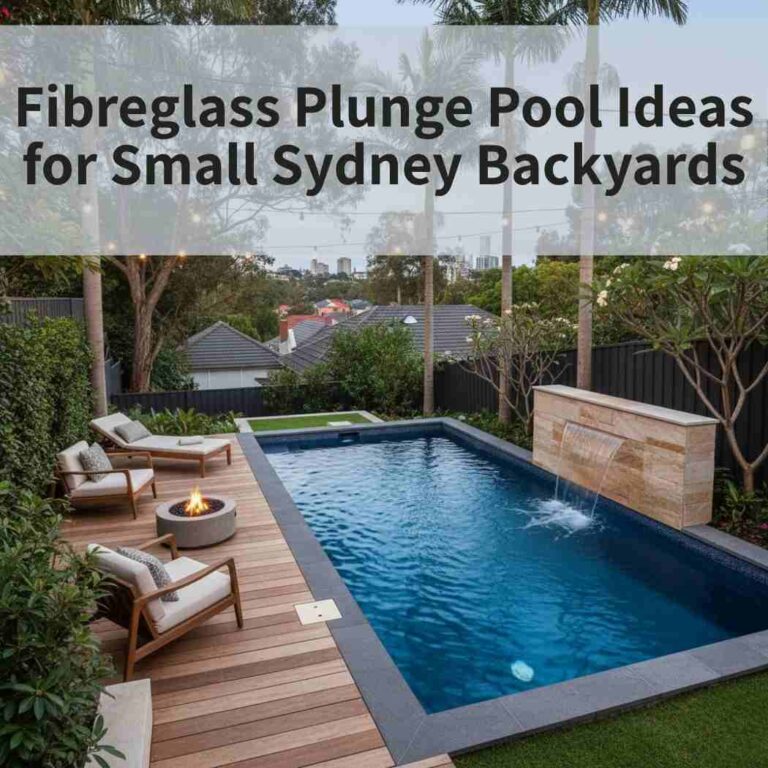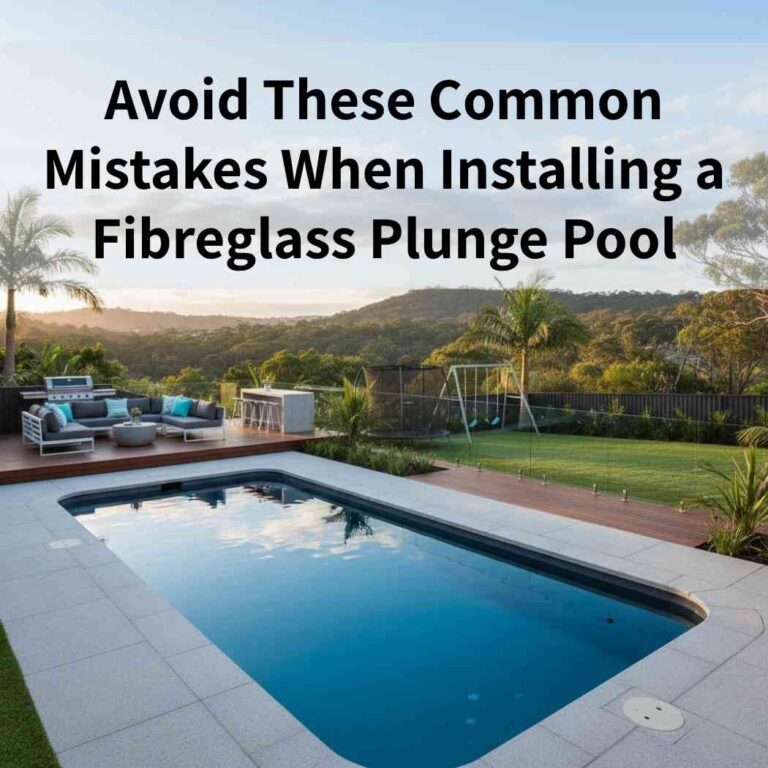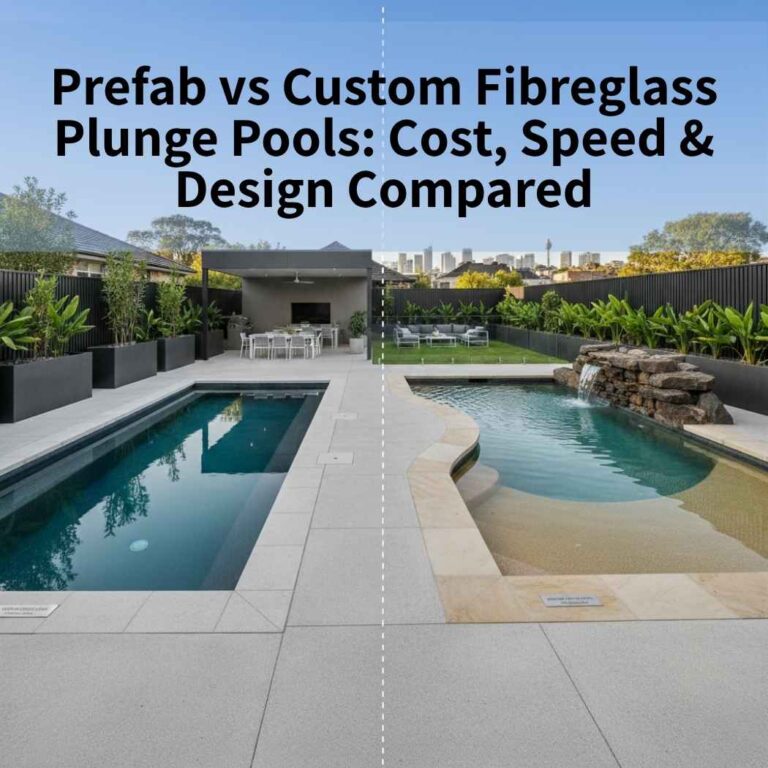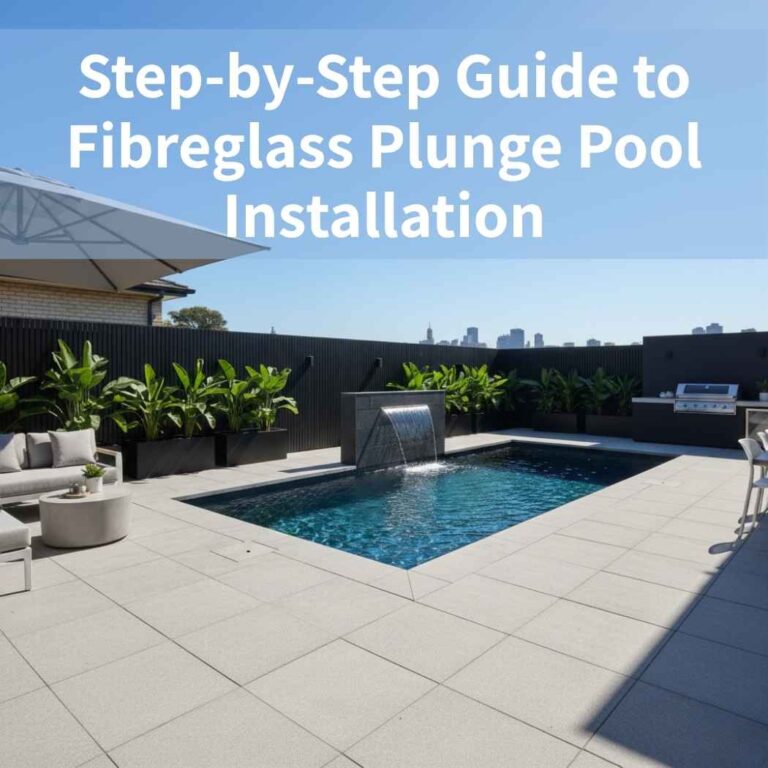At Plunge Pools Sydney, we offer complete solutions—from choosing the right pool model to full-service installation and aftercare. With years of experience, we help clients create hassle-free plunge pool setups that suit their space and budget.
This article breaks down the key cost factors, benefits, and practical tips to help you get the most value from your above-ground plunge pool investment.
Table of Contents
ToggleWhat Is an Above Ground Plunge Pool?
An above-ground plunge pool is a compact, no-fuss swimming pool designed for relaxation, hydrotherapy, or cooling off during Sydney’s brutal summers. Unlike traditional in-ground pools that need heavy excavation, these sit on or slightly above ground level. They come in different shapes, sizes, and materials—fibreglass and concrete being the most common. You can also upgrade them with features like built-in seating, heating, and advanced filtration systems.
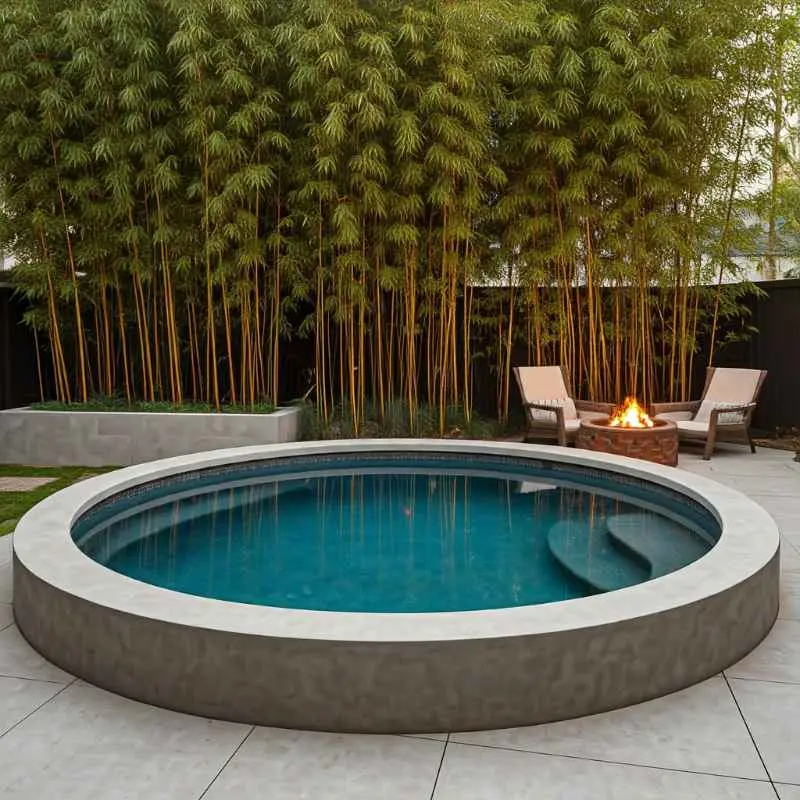
Key Characteristics
- Smaller footprint: Smaller footprint means they fit in backyards, courtyards, and rooftops.
- Shallower depth: Shallower depth focuses on relaxation rather than swimming laps.
- Versatility: Versatile enough to be placed almost anywhere, even indoors if your structure allows.
If you’re looking for a pool without the massive cost and commitment of an in-ground setup, an above-ground plunge pool is the way to go.
Why Choose an Above-Ground Plunge Pool
Thinking about getting a pool but stuck between an above-ground plunge pool and a traditional in-ground setup? Here’s why the above-ground option is a no-brainer.
1. Lower Costs
In-ground pools cost a fortune. Above-ground plunge pools? Way more affordable. Whether you’re on a tight budget or just don’t want to burn cash on unnecessary digging and construction, this is the smarter option. Perfect for families, businesses, and anyone who wants a pool without the insane price tag.
2. Faster Installation
Why wait weeks when you can have a pool in days? Prefabricated plunge pools come ready to go, meaning less time dealing with construction and more time actually enjoying the water. No long delays, no stress, just quick results.
3. Flexibility & Portability
Renting? Planning to move? No problem. Unlike in-ground pools that stay stuck where they’re built, above-ground plunge pools can be relocated. Take your investment with you instead of leaving it behind.
4. Minimal Excavation
Less digging means less cost, less mess, and less damage to your yard. Forget major land prep—these pools sit on or just above the ground, saving you thousands in excavation and landscaping repairs.
5. Regulatory Simplicity
Council approvals can be a nightmare with in-ground pools. Above-ground plunge pools? Way easier. Fewer restrictions, fewer permits, and way less red tape. Less paperwork means you can get straight to enjoying your pool without jumping through hoops.
Understanding Above Ground Plunge Pool Costs
Labor Fees
Getting professionals to install your plunge pool isn’t free, but it’s worth it. Expect to pay anywhere from $500 to $2,500, depending on how complex the job is. The easier the setup, the cheaper it gets.
Site Preparation
Not all backyards are ready for a pool straight away. If your site needs levelling, clearing, or extra groundwork, prep costs can run between $500 and $3,000. Accessibility, terrain, and landscaping all play a role in how much you’ll spend.
Not sure where to start? Here’s a guide on what’s the best base for your above-ground plunge pool depending on your soil and backyard conditions.
Permits and Regulatory Requirements
No one likes dealing with council red tape, but it’s part of the process. Permits, compliance checks, and fencing regulations will typically set you back $500 to $2,000. Some locations have fewer restrictions, which means lower costs.
Materials and Assembly
What your pool is made of changes the price big time. Fibreglass is generally cheaper and faster to install, while concrete gives you more customisation but costs more. Choose wisely based on your budget and how long you plan to stay.
Average Cost Breakdown of Above Ground Plunge Pool
Let’s talk numbers. Prices vary, but here’s a rough breakdown of what you’re looking at for a basic above-ground plunge pool in Sydney. No fluff—just real costs.
| Component | Approximate Cost |
|---|---|
| Above-ground pool kit | Around $15,000 |
| Professional Installation | Around- $7,500 |
| Pool Deck (optional) | Around $6,000 |
| Fencing and Safety | Around $5,000 |
| Permits and Approvals | Around $1,500 |
| Total | $35,000+ (including installation and labour) |
These ranges are meant to give you a ballpark figure, but every project is unique.
Factors That Affect Above Ground Plunge Pool Costs
Plunge pool prices aren’t one-size-fits-all. Several key factors determine whether you’re on the lower or higher end of the cost spectrum. Here’s what drives the numbers up—or keeps them in check.
1. Size of the Pool
Bigger pool, bigger price tag. More materials, more labour, more cost. A compact above-ground plunge pool is far cheaper to buy and install than a large one. If budget matters, size is your first lever.
2. Material Choice
Fibreglass or concrete? Fibreglass is generally cheaper upfront, quicker to install, and lower maintenance. Concrete costs more but offers unlimited customisation. It’s the classic battle of cost vs. flexibility—choose what suits your long-term plans.
3. Site Preparation
A flat, open site makes life easy and keeps installation cheap. Got sloping land, rocky terrain, or tricky access? Be ready for extra costs. If heavy equipment can’t get in, expect manual labour fees to climb fast.
4. Installation Method
DIY vs. professional install—this choice alone can swing costs by thousands. Doing it yourself saves money but also comes with risks. Hiring professionals ensures plumbing, electrical, and structural work meets all regulations (and saves you from costly mistakes).
5. Location and Access
Urban areas, tight spaces, or yards with limited access mean higher labour costs. If trucks and machinery can’t get in easily, installation gets more complicated—and more expensive.
6. Permits and Pool Fence Requirements
Regulations vary by council, but permits are unavoidable. Pool fencing is mandatory and adds to the total cost. Ignoring compliance isn’t an option, so factor this into your budget.
7. Features and Add-Ons
Lighting, heating, spa jets, filtration upgrades—they all push costs higher. Want a deck or landscaping around your pool? That’s extra too. The more features, the bigger the final bill.
8. Seasonal Use and Maintenance
It’s not just about installation. Ongoing maintenance—chemicals, cleaning, potential seasonal closures—adds up over time. A cheap install means nothing if upkeep costs are sky-high. Budget for the long game.

Materials and How They Impact Cost
Choosing the right material can significantly affect your pool’s price, aesthetics, and longevity.
Fiberglass Above Ground Plunge Pools
- Pros: Quicker installation, a smooth finish that’s gentle on skin, and minimal long-term maintenance. Fiberglass shells can be prefabricated, making them easy to transport and install.
- Cons: Limited in shape and size (due to prefabrication). Repairs can be more specialised if the gel coat is damaged.
Concrete Above Ground Plunge Pools
- Pros: Highly customisable in shape, size, and design features. Concrete is durable and can last for decades if well-maintained.
- Cons: Typically more expensive and time-consuming to install than fiberglass. Ongoing maintenance may also be pricier.
They also offer impressive longevity. See how long fibreglass and concrete above-ground pools can last with proper care.
Additional Aboveground Pool Costs to Consider
Beyond the basic pool shell and installation, you’ll need to account for a handful of other expenses to ensure your new plunge pool is both functional and compliant:
| Item | Cost | Description |
|---|---|---|
| Land Prep | $500 – $3,000 | Levelling, removing rocks, adding or adjusting retaining walls if necessary. |
| Pool Filters, Pumps, Heaters | $500 – $3,000 | Essential for water quality and comfort; premium systems may initially cost more but offer long-term savings on energy and maintenance. |
| Aboveground Pool Deck | $1,500 – $5,000 | Cost covers materials (timber, composite, etc.) and labour. A well-designed deck enhances the appearance and usability of the pool area. |
| Pool Fence | $500 – $2,000 | Mandatory in Australia for permanent pools. Cost varies based on materials—glass, aluminium, or timber—and yard complexity. |
| Permits | $500 – $1,500 | Includes pool permit application and final inspection. Permit costs vary by local council regulations. |
| Water & Chemical Treatment | Annual: $200 – $500 | Initial pool filling may involve additional costs. Ongoing chemical supplies (pH balancers, sanitisers) are required for maintaining healthy water. |
Cost-Saving Tips
Above-ground plunge pools are already a budget win, but here’s how to cut costs even more:
- DIY Where You Can If you’re good with tools, assembling a pool kit yourself can slash costs. But leave electrical work to the pros—compliance and safety come first.
- Get Multiple Quotes Shop around. Different suppliers and contractors offer different deals. Prices shift based on promotions, stock levels, and seasonal demand.
- Install in the Off-Season Winter is slow for pool builders. Less demand = better prices. If you can wait, you’ll likely save.
- Keep It Simple (For Now) Start with a basic setup. You can always add extras—like decking, advanced filtration, or decorative features—later when you have the budget.
Permits, Regulations, and Pool Fences
Permit Costs
Sydney councils set their own pool permit fees, and they’re all over the place. Expect to fork out anywhere from $200 to $800, sometimes even $500 – $1,500, depending on what’s needed. Check with your local council so you’re not caught off guard.
Fencing Compliance
Australia’s strict pool fencing laws exist for a reason—safety. If you have kids or pets, compliance isn’t optional. Your fence needs to meet height and gate requirements, and regular maintenance is non-negotiable.
Height and Volume Limits
Some councils regulate how high your above-ground pool can sit and how much water it can hold. Cross those limits? More paperwork, more approvals, and possibly more structural work.
Electrical and Plumbing Codes
Whether you’re DIY-ing or hiring a pro, everything must meet Australian electrical and plumbing codes. Fail compliance, and you’ll have headaches during council inspections—or worse, when trying to sell your home.
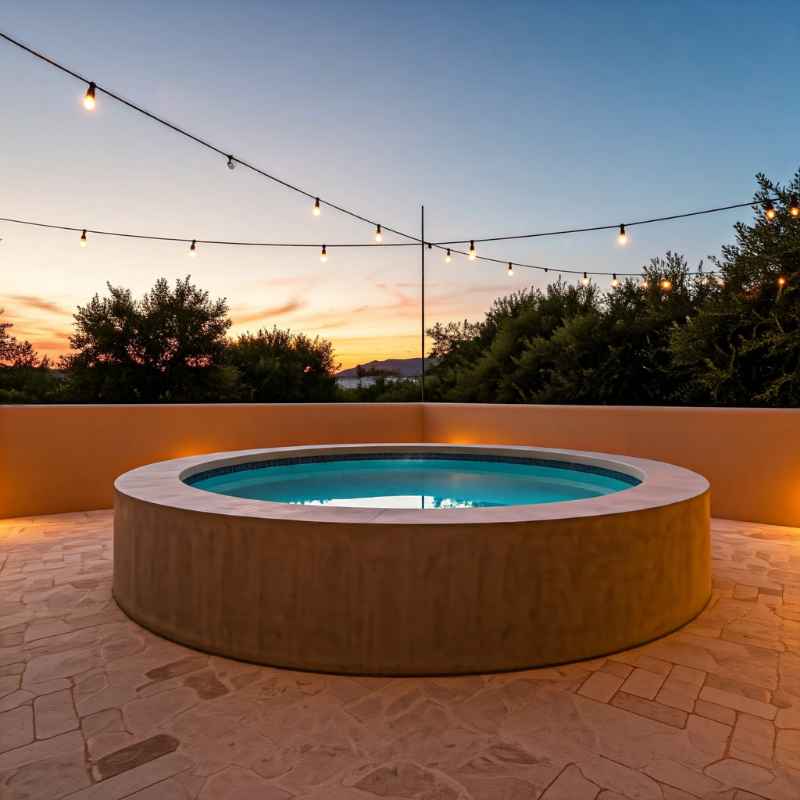
Conclusion
The cost of an above-ground plunge pool in Sydney? It depends. Pool you choose, materials, and customisation all play a role. Then there’s upkeep—cleaning and debris removal alone can run you $100 a month or more. But get it right, and you’ve got a backyard oasis that’s low-maintenance and perfect for summer.
Thinking about taking the plunge? Plunge Pools Sydney has you covered. From picking the right pool to landscaping and compliance, we take care of the hard stuff so you don’t have to. Get in touch today, and you’ll be cooling off in no time.
Get expert advice and professional above-ground plunge pool installation tailored to your backyard.
People Also Ask
How much should I budget for an above ground pool?
Factor in both setup and maintenance. A ballpark figure? around $35,000 including installation and labour. Size, materials, and extras all shift the price up or down.
How much does it cost to keep up an above ground pool?
Maintaining an above-ground plunge pool costs $50–$150 per month or $600–$1,800 per year, covering water treatment, chemical balancing, filter changes, and occasional repairs. It’s still cheaper than an in-ground pool, thanks to its smaller water volume and lower energy use, making upkeep more affordable and hassle-free.
Can I install an above-ground plunge pool myself to reduce costs?
You could, but we suggest leaving it to the pros. While DIY saves on labor costs, mistakes can lead to expensive fixes down the line. A professional installation ensures safety, compliance, and quality, giving you peace of mind that your plunge pool is built to last.
How do DIY installation costs compare to professional installation for above-ground plunge pools?
DIY cuts upfront costs—if you know what you’re doing. A professional job? More expensive but safer, code-compliant, and stress-free. In Sydney, where regulations are tight, that peace of mind is worth every dollar.

